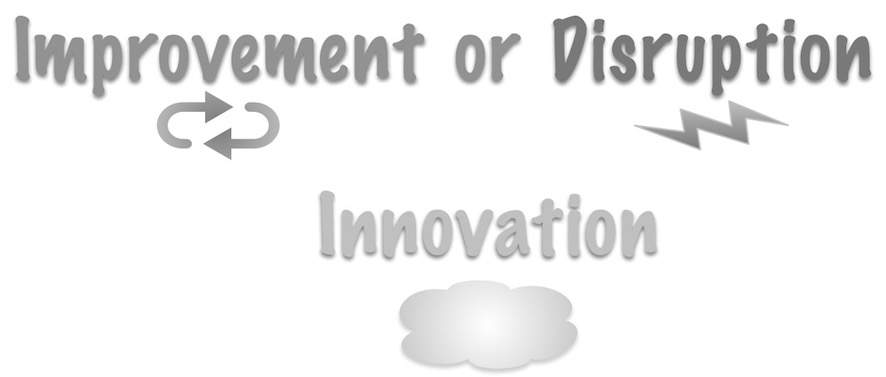 I have recently been confronted with some interesting innovations on different clients’ projects, showing, besides the benefits, some similar issues. One case with a mainly technical innovation, the other with a complete digitalization of a process previously delegated as administrative tasks (digitalized as well).
Innovation is often a good thing, sometimes even key to grow or to maintain a reasonable cost compared to competitors. It’s always an interesting experience as it “shakes” our habits, gives us new options, and offers new points of view on activities we have engaged on, sometimes for decades.
Innovating is etched in our practices, a great part of what we do as architects is making possible and supporting new and improved processes, products and interactions for the different stakeholders we work for, may they be businesses or IT.
But innovating can become an habit in itself. Especially the improvement innovation. Using a more robust solution, a more powerful technology, adding some new “best practices” to maintain a better service or faster operations. But in those cases, we were integrating some disruptive innovations.
Interestingly, we didn’t have many issues with the innovations themselves, people did a relatively great job implementing them, they were well received, the breakthrough they were to deliver was quite clear. Most issues were caused by considering that what we did previously, processes and technologies improved during decades, were still relevant. Expecting the problems and solutions to be similar, using the same processes or practices to respectively reduce and build them. What became clear was that we had to rethink some of the solutions (the previous innovations) some considered as a given.
By innovating, in those cases, we changed where we were in the solution space. Giving us many new and improved options, cheaper, faster, and simpler. But we also lost the iterative improvement done on past-solutions, we also broke some processes most actors considered imperative. We lost months combating inadequate processes or certainties that were not relevant anymore in this new solution space. Worst, a lot of actors spent a great deal of time to try to rebuild those processes and solutions as they were.
Perhaps a lesson would be to spend more time during the first phases of a project on the disruption embarked by using innovative solutions, differentiate them from improvement and identified with the different stakeholders what those innovation will change for them and what processes and solutions need to be adapted or used more carefully.
In both cases, the result remained positive, but obviously, time could have been better spent and more enjoyably improving those solutions instead of fighting them in the wrong space and slowly aligning most of the actors. In that dimension as well, digital happiness could be an inspiring dimension for architects.
I have recently been confronted with some interesting innovations on different clients’ projects, showing, besides the benefits, some similar issues. One case with a mainly technical innovation, the other with a complete digitalization of a process previously delegated as administrative tasks (digitalized as well).
Innovation is often a good thing, sometimes even key to grow or to maintain a reasonable cost compared to competitors. It’s always an interesting experience as it “shakes” our habits, gives us new options, and offers new points of view on activities we have engaged on, sometimes for decades.
Innovating is etched in our practices, a great part of what we do as architects is making possible and supporting new and improved processes, products and interactions for the different stakeholders we work for, may they be businesses or IT.
But innovating can become an habit in itself. Especially the improvement innovation. Using a more robust solution, a more powerful technology, adding some new “best practices” to maintain a better service or faster operations. But in those cases, we were integrating some disruptive innovations.
Interestingly, we didn’t have many issues with the innovations themselves, people did a relatively great job implementing them, they were well received, the breakthrough they were to deliver was quite clear. Most issues were caused by considering that what we did previously, processes and technologies improved during decades, were still relevant. Expecting the problems and solutions to be similar, using the same processes or practices to respectively reduce and build them. What became clear was that we had to rethink some of the solutions (the previous innovations) some considered as a given.
By innovating, in those cases, we changed where we were in the solution space. Giving us many new and improved options, cheaper, faster, and simpler. But we also lost the iterative improvement done on past-solutions, we also broke some processes most actors considered imperative. We lost months combating inadequate processes or certainties that were not relevant anymore in this new solution space. Worst, a lot of actors spent a great deal of time to try to rebuild those processes and solutions as they were.
Perhaps a lesson would be to spend more time during the first phases of a project on the disruption embarked by using innovative solutions, differentiate them from improvement and identified with the different stakeholders what those innovation will change for them and what processes and solutions need to be adapted or used more carefully.
In both cases, the result remained positive, but obviously, time could have been better spent and more enjoyably improving those solutions instead of fighting them in the wrong space and slowly aligning most of the actors. In that dimension as well, digital happiness could be an inspiring dimension for architects.
Select your location
 English | EN
English | EN


